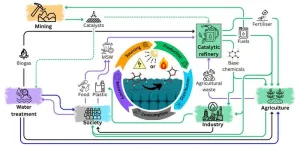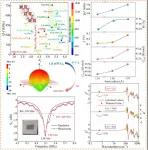(Press-News.org) The chemical industry is a cornerstone of global development, driving innovation, and providing essential products that support our modern way of life.
However, its reliance on unsustainable fossil resources has posed significant threats to global ecosystems through climate change and chemical pollution.
A new commentary published in Cell Press’ OneEarth co-authored by Griffith University researchers puts forth a transformative solution: catalysis to leverage sustainable waste resources, ushering the industry from a linear to a circular economy.
“If we look at recent statistics, the chemical industry contributes a staggering US$5.7 trillion to the global economy and sustains 150 million jobs worldwide, excluding refined fossil fuels,” said Professor Karen Wilson, one of the lead authors and Director of Griffith’s Centre for Catalysis and Clean Energy.
"But it remains the largest industrial energy consumer and the third-largest emitter of direct CO2 emissions globally.”
In 2022, the industry emitted 935 million metric tons of CO2 during primary chemicals production. Moreover, its operations have led to significant water contamination and the release of toxic chemicals into the environment, perpetuating a cycle of ecological harm.
Co-lead author Professor Adam Lee, also based at Griffith, said: “Catalytic processes could minimise reliance on finite fossil fuels and curb CO2 emissions significantly by harnessing agricultural, municipal, and plastic waste as feedstocks.
“This feedstock transition not only mitigates environmental damage but also addresses vulnerabilities in the industry's supply chain, which are susceptible to geopolitical and natural disruptions.”
Professor Wilson added: “Catalysis has historically played a key role in transforming fossil resources into essential fuels and products, and now offers a beacon of hope for revolutionising the chemical industry and promoting a circular economy.”
However, the authors acknowledge that this vision demands concerted innovation in catalyst formulation and process integration.
“Prioritising Earth-abundant elements over precious metals will unlock sustainable catalytic systems for the efficient conversion of organic waste into benign and recyclable products,” Professor Wilson said.
“Already, pioneering initiatives such as the co-location of different industries in Kalundborg, Denmark to foster symbiosis have demonstrated new collaborative models to improve resource efficiency and waste reduction.”
"Catalysis offers a pathway towards sustainability, enabling us to transform waste into valuable resources and pave the way for a circular economy," Professor Lee added.
In the OneEarth commentary, the team explored sources of catalysis for sustainable and circular chemical processes through the following lenses:
Catalysis to enable waste biomass utilisation
Catalysis for circular polymers
Catalysis to remediate chemical pollution
The commentary ‘Catalysis at the Intersection of Sustainable Chemistry and a Circular Economy’ has been published in OneEarth.
END
Can we revolutionise the chemical industry and create a circular economy? Yes, with the help of catalysts
2024-05-17
ELSE PRESS RELEASES FROM THIS DATE:
Rutgers researchers identify impacts of Russia-Ukraine war on hospitals
2024-05-17
Rutgers researchers, aided by international collaborators, have tracked the devastation war has made on Ukraine’s hospital system.
Hundreds of hospitals in Ukraine have been forced to close or operate at a reduced capacity since Russia’s invasion of the Eastern European country in February 2022. Damage, destruction and supply shortages caused by the war have impaired the nation’s hospital system and taken a serious toll on human health.
In a study published in JAMA, Rutgers researchers and collaborators from the United States, Pakistan and Ukraine collected and compared data on hospital services provided both during ...
Differing values of nature can still lead to joined up goals for sustainability
2024-05-17
Recognising and respecting the different ways nature is valued can enable better environmental decision-making, according to new research led by the University of East Anglia (UEA).
International agreements such as the Sustainable Development Goals represent wide support for a sustainable future, living within planetary boundaries and ensuring a safer future for current and next generations.
However, there remain huge disagreements about how to advance such goals, often resulting in marginalisation, conflict and inaction.
The paper, published in the journal One Earth, ...
Ultraprocessed food consumption and cardiometabolic risk factors in children
2024-05-17
About The Study: The findings of this study suggest that high ultraprocessed food (UPF) consumption in young children is associated with adiposity and other cardiometabolic risk factors, highlighting the need for public health initiatives to promote the replacement of UPFs with unprocessed or minimally processed foods.
Corresponding Author: To contact the corresponding author, Nancy Babio, Ph.D., email nancy.babio@urv.cat.
To access the embargoed study: Visit our For The Media website at this link https://media.jamanetwork.com/
(doi:10.1001/jamanetworkopen.2024.11852)
Editor’s ...
Link between e-cigarette use and early age of asthma onset in US adults found through UTHealth Houston research
2024-05-17
A significant link between the use of electronic cigarettes and earlier age of asthma onset in U.S. adults was reported by UTHealth Houston researchers May 17, 2024 in the Journal of the American Medical Association (JAMA) Network Open.
Led by first author Adriana Pérez, PhD, MS, professor of biostatistics and data science at UTHealth Houston School of Public Health, the research found that adults who were asthma-free at the beginning of the study and reported e-cigarette use in the past 30 days increased their risk of developing earlier age of asthma onset by 252%.
“While previous studies have reported that e-cigarette use increases ...
UNC Greensboro researcher approved for NCInnovation grant funding for lithium refining research
2024-05-17
UNC Greensboro researcher Hemali Rathnayake, Ph.D., has been approved for grant funding from NCInnovation to continue her work in developing a cost-effective and efficient lithium refining process for converting lithium into battery-grade lithium carbonate.
The grant approval is conditioned on standard next steps, including executed grant agreements and formal notification to government partners. This funding is part of NCInnovation’s larger mission to unlock the innovative potential of North Carolina’s world-class universities.
“From ...
Plants restrict use of “Tipp-Ex proteins”
2024-05-17
Plants have special corrective molecules at their disposal that can make retrospective modifications to copies of genes. However, it would appear that these “Tipp-Ex proteins” do not have permission to work in all areas of the cell, only being used in chloroplasts and mitochondria. A study by the University of Bonn has now explained why this is the case. It suggests that the correction mechanism would otherwise modify copies that have nothing wrong with them, with fatal consequences for the cell. The findings have now been ...
New AI tool to help beat brain tumors
2024-05-17
A new AI tool to more quickly and accurately classify brain tumours has been developed by researchers at The Australian National University (ANU).
According to Dr Danh-Tai Hoang, precision in diagnosing and categorising tumours is crucial for effective patient treatment.
“The current gold standard for identifying different kinds of brain tumours is DNA methylation-based profiling,” Dr Hoang said.
“DNA methylation acts like a switch to control gene activity, and ...
Antioxidant Dietary Supplement “Twendee X®” can help counter systemic sclerosis
2024-05-17
Autoimmune diseases occur when the body’s immune system attacks healthy cells instead of protecting them. Systemic sclerosis (SSc) is one such autoimmune condition characterized by faulty circulatory and immune systems, leading to the occurrence of fibrosis (hardening and scarring of healthy tissue) of the skin and internal organs. SSc is known to affect patients throughout their lives, thereby, impairing their quality of life. Although precise mechanisms underlying SSc development and progression are not clearly understood, a complex interplay of immune, hormonal, environmental, and genetic factors is often implicated.
Moreover, ...
Low-permittivity LiLn(PO3)4 (Ln = La, Sm, Eu) dielectric ceramics for microwave/millimeter-wave communication
2024-05-17
Microwave dielectric ceramics are the cornerstone of wireless communication devices, widely utilized in mobile communications, satellite radar, GPS, Bluetooth, and WLAN applications. Components made from these ceramic materials, such as filters, resonators, and dielectric antennas, are extensively used in wireless communication networks. As wireless communication frequencies extend into higher bands, signal delay issues become increasingly prominent. Low dielectric constants (εr) can reduce electromagnetic coupling effects, effectively minimizing signal delays. Consequently, developing new ceramic materials with ...
Online dashboard to help save children from dangerous diarrheal diseases
2024-05-17
University of Virginia researchers are developing a flexible online tool for navigating information used in the fight to save children from deadly diarrheal diseases by identifying transmission hotspots and accelerating the deployment of treatments and new vaccines.
Diarrhea not only kills hundreds of thousands of children around the world every year, it contributes to malnutrition that can prevent kids from growing and developing to their full potential both physically and mentally, trapping them in poverty. While significant progress has been made against ...






